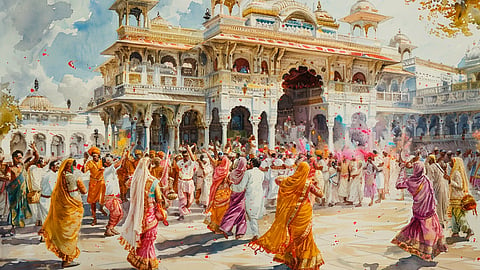- Commentary
- History Vignettes
- Notes on Culture
- Dispatches
- Podcasts
- Indian LanguagesIndian Languages
- Support

IF THIS IS THE COMMERICAL SIDE of the Kutchi Bhāṭiyās, the cultural side presents a deeply expressive picture. It was entirely characteristic of the Hindu social solidarity in alien lands of that period. Economic competition was no obstacle to this solidarity. The Bania community especially, was represented by the most respected man in the community. His title by itself showed its deep cultural moorings in Bharatavarsha. He was known as the Nagar Seth or Mukhi, and represented the community in political matters. In the late 19th century, this office was held by a Bhimani, belonging to the aforementioned Gopal Bhimani’s bloodline.
The Hindu community celebrated all its major festivals like Holi, Janmashtami and Deepavali with the same fervour as they did in Bharatavarsha. Community dinners on these festivals were basically the partaking of Prasadam. A large platter of the best food would be sent to the Sultan’s palace. However, Hindus politely declined to eat the food that the Sultan offered in return, if it was prepared by non-Hindu cooks. Hindus wore their traditional attire and mostly spoke Gujarati. Account books were also maintained in Gujarati.
The Hindu community also maintained a Gaushala, which supplied the dairy needs for Muscati Hindus. This Gaushala has a story of its own. It was located adjacent to the selfsame Motishwar Mandir, which Prime Minister Narendra Modi visited in 2018. When the Oman National Dairy was opened in 1976, the Hindu community donated the Gaushala cows to it on one condition: once the cows stopped producing milk, they should not be slaughtered, but sent to India. This story is also a footnote of sorts to the present fate of the four Hindu temples in Muscat. This is Calvin Allen’s observation, made in the 1970s:
“…the Govindaraj temple, the Haveli, known as Bävaji, which is one of the two temples that still exist in Masqat, a Kalka temple situated on the Masqat side of the pass to Riyam and a large Siva temple, known as Motisvar, located in the Rawiyya section of Masqat. The Kälka temple, utilized by the small but influential Gosain Brahmin community in Masqat, included a graveyard to accommodate the Gosain practice of burying their dead in a seated position. The temple was demolished in 1970 to make way for a road, and the idol is now stored in the Bavaji temple. Motisvar was built near a large banyan tree and contained two wells. The temple became the centre of Hindu social life in Masqat as well as the water source for the community. It has been rebuilt recently, and contains, beside the linga representing Siva, Nandi, Siva's mount, and a turtle, as well as a small shrine to Hanumant. The Hindu community also…continues to utilize, a burning ghät for the cremation of its dead, a cow pen, no longer in use, and a gupha, or 'holy cave', located in the mountains near Sidab.”
In the mid to late 19th century, four eminent Hindus were recognised as the pillars of the Hindu community in Muscat. Dowlatgirji Manrupgirji, a Gosai Brahmana from Kutch; Virji Ratansi, a well-respected banker; Damodar Dharamsi, a customs-farmer; and Ratansi Purshottam, a fabulously wealthy magnate with diverse business interests. They offered protection, patronage and encouragement to scores of other Banias who established lucrative businesses in Muscat.
Calvin Allen offers an overall assessment of three centuries of Hindu economic prowess in Muscat, which was seeded by the Sindhi Bhāṭiyās and taken to Himalayan heights by the Kutchi Bhāṭiyās:
“Over the course of the nineteenth century, Indian merchants came to dominate the economic life of Masqat, replacing the Al Bü Said rulers as the principal merchants of the city and acquiring fortunes that had once gone to the royal family. The Hindu Banias, who had first come from Sind as junior partners to the Portuguese, flourished under the Ya'ariba but suffered as a result of the combined strains of political and economic dislocations at home and a more aggressive Masqati commercial policy…”
The glory enjoyed by the Kutchi Bhāṭiyās was too good to last.
The first blow came in the form of the hardcore bigot, Imam Azzan bin Qais who deposed his cousin, Sultan Thuwayni bin Said in 1868. He established a fundamentalist regime and ousted the Kutchi Bhāṭiyās from all the government posts they held.
Next, he specifically targetted all the Hindus in Muscat. He imposed stifling prohibitions on dress, music, and social mores. He banned tobacoo and prohibited Hindus from ringing bells, gongs and drums on auspicious occasions. And then he unleashed his fanatical hordes who began physically attacking the Banias. As anticipated, a wave of Hindu exodus began. In just two years, the Hindu population of Muscat fell from 2000 to 250.
BY ANY MEASURE, this three-century saga is a thrilling journey of a small slice of Hindu business history imbued with epic elements. It is a relatively recent proof of V.S. Agarwala and Motichandra’s profound observation about the intrinsic temperament of the Hindu attitude to business, quoted in the beginning of this essay series.
The manner in which the Hindu business community preserved its Dharma, its traditions and values in a Mleccha land imparts several invaluable lessons. The foremost lesson is the indivisibility of culture and economics. Economics safeguards and nourishes culture, and culture spiritualises economics. Economics divorced from culture and spirituality leads to financial cannibalism, and financial cannibalism is the very definition of American style capitalism.
|| Om Tat Sat ||
Series concluded
The Dharma Dispatch is now available on Telegram! For original and insightful narratives on Indian Culture and History, subscribe to us on Telegram.
